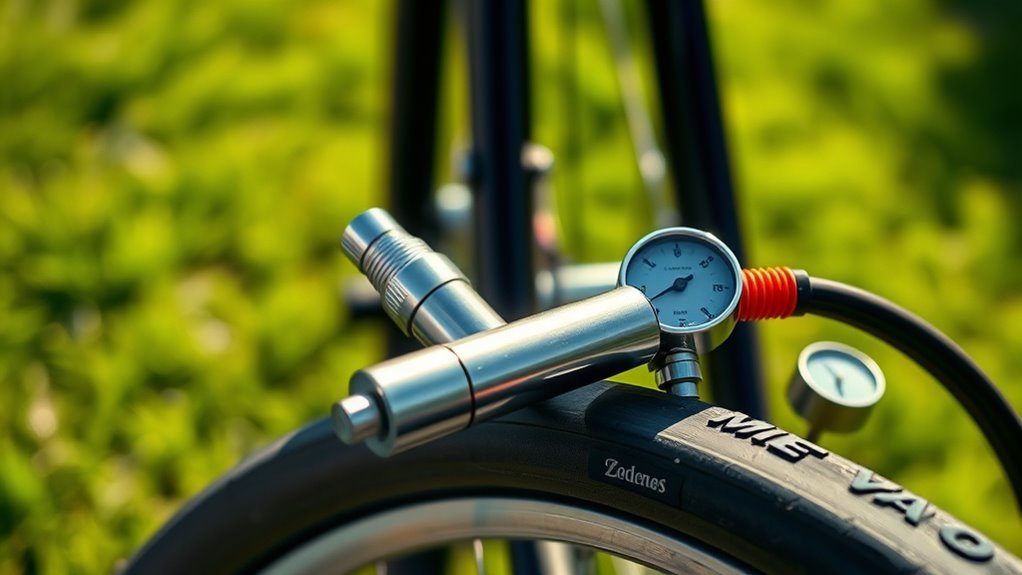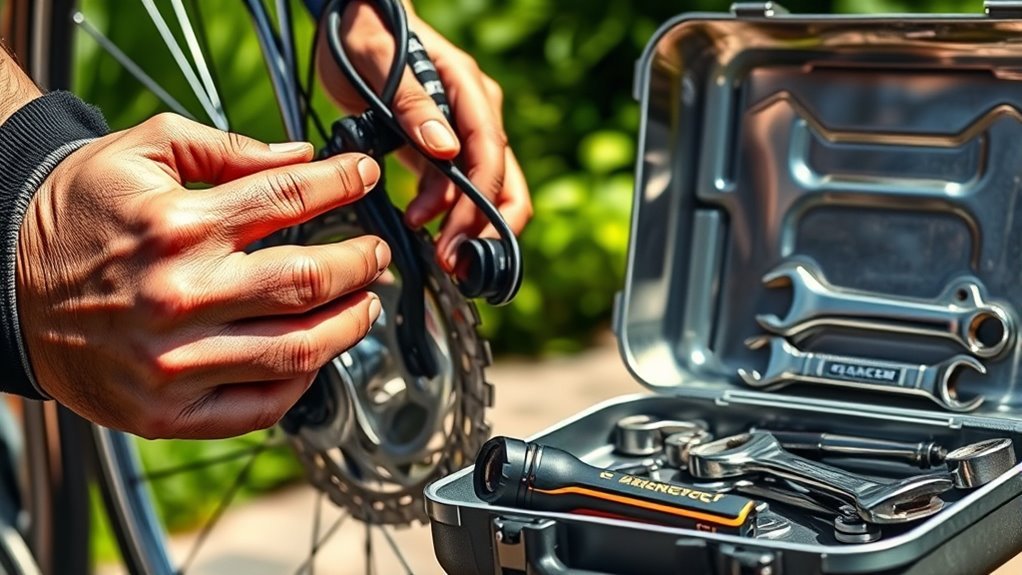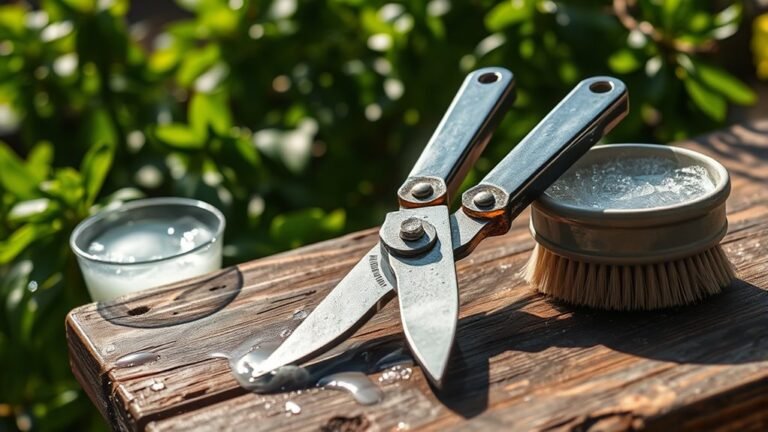Daily Maintenance Tips for Bike
You should check your tire pressure daily, inflating to the PSI marked on the sidewall, and inspect for tread wear or damage. Clean your chain regularly with a degreaser, then lightly lubricate to keep it moving smoothly. Examine brake pads for wear and test their responsiveness. Adjust gear shifts using the barrel adjuster for smooth changes. Wipe down the frame and components to prevent corrosion, and verify all bolts and fasteners are tight and secure. Following these steps will optimize your bike’s performance and safety, with additional techniques available to enhance maintenance.
Checking and Inflating Tires

Before you hit the road, it’s crucial to check your bike tires for proper pressure and any signs of damage. Use a reliable pressure gauge to measure tire pressure, matching it to the recommended PSI indicated on the tire sidewall. Maintaining correct tire pressure optimizes rolling efficiency and reduces the risk of flats. Inspect the tread wear carefully; uneven or excessive wear signals the need for tire replacement to maintain traction and control. Additionally, examine the sidewalls for cuts, cracks, or bulges that compromise structural integrity. If the pressure is low, inflate the tires using a pump equipped with a pressure gauge to avoid overinflation. Regularly monitoring tire pressure and tread wear guarantees your bike responds predictably, granting you the freedom to ride confidently and safely on any terrain.
Cleaning and Lubricating the Chain
To keep your bike chain running smoothly, you need to clean it regularly using methods like degreasing with a brush or a chain cleaning tool. After cleaning, apply lubricant sparingly to avoid attracting dirt while ensuring each link moves freely. Proper lubrication techniques can greatly extend your chain’s lifespan and improve shifting performance.
Chain Cleaning Methods
Although it might seem straightforward, cleaning and lubricating your bike chain requires a methodical approach to secure peak performance and longevity. Start by selecting appropriate chain cleaning tools, such as a chain scrubber or stiff-bristle brush combined with a biodegradable degreaser. Remove excess grime and old lubricant by running the chain through the cleaning device while rotating the pedals backward. Rinse with water and thoroughly dry to prevent rust. Keep an eye on chain maintenance frequency—cleaning should occur every 100-200 miles or sooner in harsh conditions like rain or mud. Regularly scheduled cleaning preserves drivetrain efficiency and reduces wear. By adhering to a precise cleaning routine, you safeguard your bike’s freedom on the road or trail remains unhindered, maintaining reliable power transfer and smooth shifting.
Lubrication Best Practices
Since proper lubrication is crucial for reducing friction and preventing wear, you’ll want to apply the right type and amount of lubricant immediately after thoroughly cleaning and drying your chain. Choosing the correct oil types and maintaining an ideal lubrication frequency guarantees smooth operation and extends your bike’s lifespan.
- Select oil types designed for your riding conditions—wet lube for rainy environments, dry lube for dusty trails.
- Apply lubricant drop-by-drop on each roller, avoiding excess that attracts dirt.
- Allow the lubricant to penetrate for several minutes, then wipe off surplus with a clean rag.
- Adjust lubrication frequency based on mileage and weather; typically, every 100-200 miles or after heavy rain.
This disciplined approach assures your chain stays efficient, letting you ride freely without mechanical interruptions.
Inspecting Brakes for Safety

Regularly inspecting your bike’s brakes is essential for guaranteeing reliable stopping power and overall safety. Start by examining the brake pads for wear; if they’re thinner than 3mm or unevenly worn, replace them promptly. Check the brake fluid level in hydraulic systems—low fluid can reduce responsiveness and indicate leaks. Squeeze the brake levers to test pressure; they should feel firm, not spongy, which might suggest air in the lines or fluid degradation. Inspect cables and housing on mechanical brakes for fraying or corrosion that could impair function. Also, verify brake calipers align correctly with the wheel rim or rotor, preventing uneven pad contact. Maintaining your brakes precisely not only preserves your freedom on the road but also safeguards your ability to stop confidently when it counts.
Adjusting Gear Shifts
If your gear shifts feel sluggish or skip, start by identifying specific issues like delayed engagement or chain noise. You’ll need to adjust the cable tension carefully to restore smooth shifting. Then, fine-tune the derailleur alignment to guarantee precise gear changes without hesitation.
Identifying Gear Shift Issues
Although you might not notice it immediately, gear shift issues can considerably affect your bike’s performance and safety. To identify problems early, focus on these key indicators:
- Listen for unusual gear noise—grinding or clicking sounds signal misalignment or wear.
- Monitor shifting smoothness; hesitation or slipping suggests adjustment needs.
- Check if the chain skips under load, indicating worn components or tension issues.
- Observe any difficulty moving the shifter levers, which could point to internal cable or derailleur problems.
Cable Tension Adjustment
Because proper cable tension directly influences gear responsiveness, adjusting it is essential for smooth shifting. Start by checking the barrel adjuster near the shifter; turning it clockwise loosens tension, while counterclockwise tightens it. Shift through your gears as you make minor adjustments to find the ideal tension where shifts are crisp and immediate. Be vigilant for signs of cable wear—fraying or corrosion—which compromises performance and demands cable replacement. If shifting remains sluggish after tension adjustment, inspect the cable housing for damage or dirt buildup. Regularly maintaining cable tension not only enhances your ride’s precision but also extends cable life, empowering you with reliable gear changes essential for freedom on every trail or road. Remember, precise cable tension is key to seamless, confident shifting.
Fine-Tuning Derailleur Alignment
When your gear shifts feel rough or inconsistent, fine-tuning the derailleur alignment is crucial for restoring smooth performance. Different derailleur types require specific attention, so knowing yours is key before starting. Use alignment tools like a derailleur hanger alignment gauge to guarantee precision.
- Shift to the smallest chainring and sprocket to reduce tension.
- Check the derailleur hanger for bends using alignment tools; straighten if needed.
- Adjust the high and low limit screws to prevent chain drops.
- Use the barrel adjuster to fine-tune cable tension, guaranteeing crisp shifts across all gears.
With precise alignment, your drivetrain performs efficiently, giving you the freedom to ride without hesitation or gear slipping.
Wiping Down the Frame and Components
Start by preparing a clean, soft cloth and a mild cleaning solution to gently wipe down the bike frame and components. Focus on removing dirt and grime without damaging the frame material—whether it’s aluminum, carbon fiber, or steel. Use minimal liquid to protect protective coatings that preserve the frame’s integrity and appearance. Pay close attention to junctions where debris accumulates, such as around the bottom bracket and headset. Avoid abrasive tools that can scratch surfaces or degrade coatings crucial to corrosion resistance. For components like derailleurs and brakes, carefully wipe to maintain performance without dislodging lubricants. Regular, precise cleaning extends your bike’s lifespan and keeps it ready for the open road, ensuring you stay free to ride without mechanical interruptions.
Securing Bolts and Fasteners

Although it might seem straightforward, securing bolts and fasteners is critical to your bike’s safety and performance. Neglecting proper bolt torque can lead to component failure or unsafe rides. Follow these fastener maintenance steps to keep your bike reliable and ready for freedom on the road:
- Use a torque wrench to tighten bolts to manufacturer-specified torque values, avoiding overtightening or under-tightening.
- Check all fasteners regularly, focusing on critical points like stem, handlebars, seat post, and brake mounts.
- Apply threadlocker on bolts prone to vibration to prevent loosening during rides.
- Inspect for corrosion or stripped threads; replace any damaged fasteners immediately.
Consistent attention to bolt torque and fastener maintenance guarantees your bike stays secure, giving you confidence and control every time you ride.
Frequently Asked Questions
How Often Should I Replace My Bike Tires?
You could ride a million miles before noticing tire wear, but realistically, you should check your bike tires regularly for replacement signs like cracks, bald spots, or frequent flats. If you see these, it’s time to replace them to maintain safety and performance. Depending on terrain and usage, tires often last 2,000 to 3,000 miles. Staying vigilant guarantees your freedom to ride smoothly without unexpected breakdowns or accidents.
What Type of Lubricant Is Best for Different Weather Conditions?
You’ll want weather specific lubricants to keep your bike running smoothly. For wet conditions, use a wet lube that repels water and prevents rust. In dry weather, a dry lube minimizes dirt buildup. Apply lubricant sparingly on the chain’s rollers and wipe off excess to avoid attracting grime—these lubricant application techniques guarantee peak performance and longevity. Tailoring your lube choice to weather keeps your ride free and efficient.
How Do I Know When Brake Pads Need Replacing?
You’ll know brake pads need replacing when you notice significant brake pad wear or a persistent squeaking noise. Check the pads visually; if the grooves are almost gone or the pad thickness is less than 3mm, it’s time to replace them. The squeaking noise often signals worn-out pads or debris caught between the pad and rotor. Maintaining proper brake function guarantees your freedom and safety while riding.
Can I Use Household Tools for Gear Adjustments?
You can use common household tools for gear shifting adjustments if they’re compatible, like small screwdrivers or Allen keys. However, precision is key—improper household adjustments might lead to poor gear performance or damage. It’s best to verify the tool sizes match your bike’s components. If you want the freedom to fine-tune your gears confidently, investing in a basic bike-specific toolset guarantees precise, reliable gear shifting without guesswork.
What’S the Best Way to Store My Bike Long-Term?
For ideal bike storage and long term care, keep your bike in a cool, dry place away from direct sunlight to prevent rust and fading. Use a bike stand or hang it by the frame to avoid tire deformation. Deflate tires slightly to reduce pressure. Clean and lubricate the chain before storing. Cover your bike with a breathable fabric to protect it from dust while allowing moisture to escape, ensuring your bike’s freedom to perform when you ride again.






